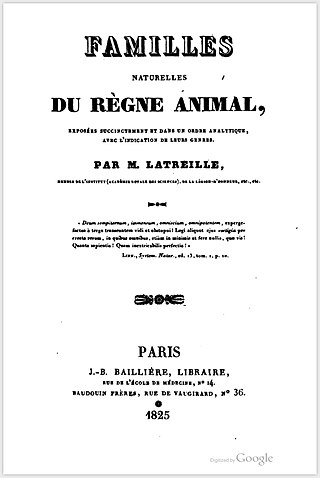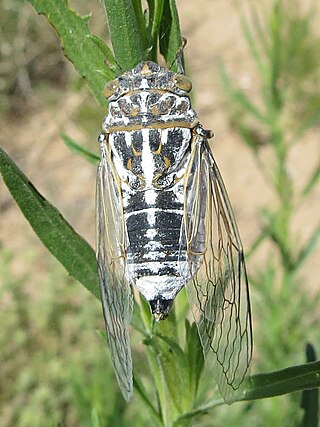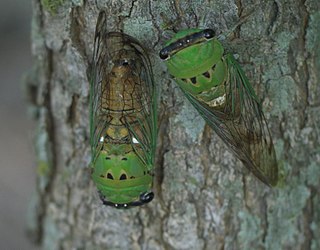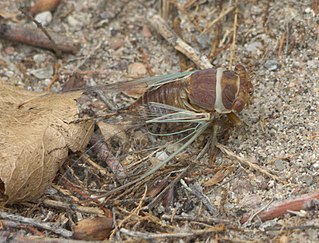
Cicadas of the genus Neotibicen are large-bodied insects of the family Cicadidae that appear in summer or early fall in eastern North America and formerly Bermuda. Common names include cicada, harvestfly, jar fly, and the misnomer locust.

Neotibicen tibicen, known generally as the swamp cicada or morning cicada, is a species of cicada in the family Cicadidae. It is widespread across much of the eastern and central United States and portions of southeastern Canada. There are two subspecies, N. tibicen tibicen and N. tibicen australis, with the latter replacing subspecies tibicen in portions of Florida, Georgia, and Alabama.

Tibicen is a historical genus name in the insect family Cicadidae that was originally published by P. A. Latreille in 1825 and formally made available in a translation by A. A. Berthold in 1827. The name was placed on the Official Index of Rejected and Invalid Generic Names in Zoology by the International Commission on Zoological Nomenclature in 2021. Certain European cicada species that were included by some authors in this genus at the time of its suppression are now listed under genus Lyristes Horváth, 1926. Other formerly-Tibicen species are placed in the tribe Cryptotympanini and include the genera Auritibicen Lee, 2015, Hadoa Moulds, 2015 Megatibicen Sanborn and Heath, 2016, and Neotibicen Hill and Moulds, 2015.

The genus Hadoa comprises large-bodied Cicadidae occurring in Western North America. Until recently, these species were in the genus Tibicen, which has now been redefined so as to include only a few European species, while most species from the Eastern and Central US are now placed in Neotibicen and Megatibicen.

Megatibicen is a genus of cicadas in the family Cicadidae, with about 10 described species. Until 2016, these species were included in the genus Tibicen and then briefly in Neotibicen. The species formerly of genera Ameritibicen Lee, 2016 and Gigatibicen Lee, 2016 are now considered species of Megatibicen Sanborn & Heath, 2016.

Megatibicen tremulus, known generally as the western bush cicada or Cole's bush cicada, is a species of cicada in the family Cicadidae. It is found in the Great Plains of the United States, often associated with Sagebrush.

Neotibicen davisi, known generally as the Davis' southeastern dog-day cicada or southern dog-day cicada, is a species of cicada in the family Cicadidae.

Neotibicen lyricen, the lyric cicada, is a species of cicada in the family Cicadidae.

Neotibicen superbus, the superb dog-day cicada, is a species of cicada in the family Cicadidae. It is the greenest cicada in the neotibicen genus. It has reduced black patterning and looks different than most other cicadas in its genus. Its song is a soft buzz that reaches a crescendo.

Diceroprocta is a genus of scrub cicadas in the family Cicadidae. There are at least 60 described species in Diceroprocta.

Dazini is a tribe of cicadas in the family Cicadidae. There are at least four genera and about eight described species in Dazini.

Neocicada is a genus of cicadas in the family Cicadidae, with about five described species.
Cornuplura is a genus of cicadas in the family Cicadidae. There are at least three described species in Cornuplura.

Cicadettini is a tribe of cicadas in the family Cicadidae. There are at least 110 genera and 520 described species in Cicadettini, found worldwide except for the Neotropics.
Cicadmalleus is a genus of cicadas in the family Cicadidae, found in Indomalaya (Thailand). There is at least one described species in Cicadmalleus, C. micheli.
Distantada is a genus of cicadas in the family Cicadidae, found in the Mascarene Islands. There is at least one described species in Distantada, D. thomasseti.
Jassopsaltria is a genus of cicadas in the family Cicadidae, found in Australia. There is at least one described species in Jassopsaltria, J. rufifacies.
Lahugada is a genus of cicadas in the family Cicadidae, found in India. There is at least one described species in Lahugada, L. dohertyi.

Neotibicen winnemanna, commonly called the Eastern scissor(s) grinder, is a species of large bodied annual cicada in the genus Neotibicen. It is native to the Eastern United States, particularly the Piedmont Plateau and the outlying lower mountainous elevations of the Appalachians and inner, western portion of the Atlantic coastal plain.

Lyristes is a genus of cicadas from Europe and the Middle East. It was described by G. Horvath in 1926.

















